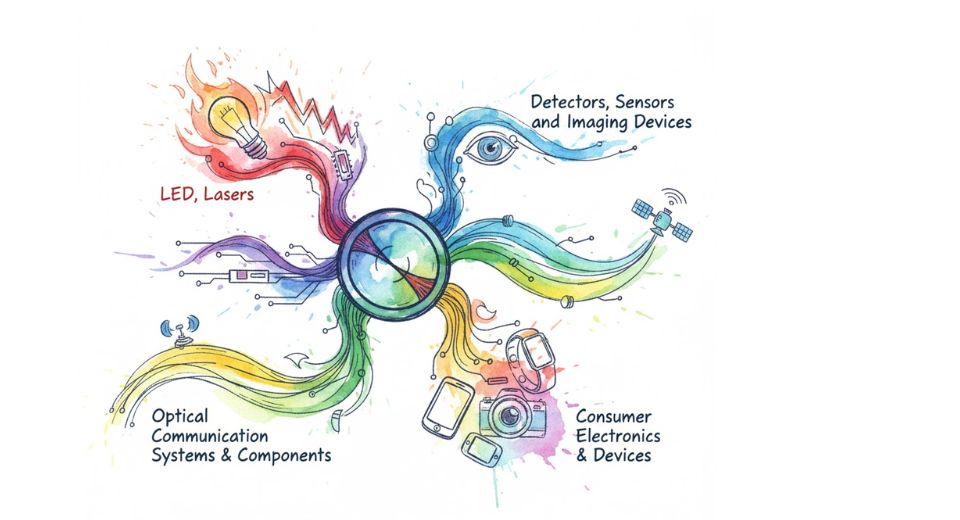
Oct 31, 2025

The latest report of the global photonics market by Metastat Insight presents a vision that connects light-based technology into daily advancement from communications infrastructures enabling instantaneous worldwide connectivity to accurate healthcare imaging and green lighting systems defining intelligent cities. As sectors evolve through green and digital turns, photonics has moved out of the lab into actual, high-impact applications that influence transport, manufacturing, and smart infrastructure. Its growing relevance is a function not just of technology progress but also of the broader trend toward clean, faster, and more intelligent systems worldwide.
Market Context
Applications in telecommunications, energy, healthcare, and manufacturing face growing demands for faster data transmission, cleaner consumption of renewable energy, and smaller precision systems. Traditional electronic systems, though powerful, are confronted with physical and efficiency limits that cap speed and scalability. These constraints have set a stage upon which optical technology is being researched as a central enabler. Light uses in data transfer, sensing, imaging, and material processing provide a pathway for industries requiring higher performance at lower energy usage. Thus, photonics is not seen as a replacement but instead as a building block constituent that becomes adaptable to the next-generation digital and sustainability operations. Its use in manufacturing lines, diagnostic instruments, and networked devices indicates the direction industries are heading to meet modern demands for efficiency and innovation.
How It Works / Why It's Valuable
Essentially, photonics is based on the control and manipulation of photons light particles to transfer, sense, and convert information or energy. The concept is applied in a number of functions such as fiber-optic communication, laser production, and optically-based sensing.
Its value lies in its ability to transmit information at a faster pace than electrical signals and support accuracy at micro and nano scales. It's applied in all from advanced medical diagnostics and environmental monitoring to self-driving navigation and semiconductor manufacturing. The ability to support speed, accuracy, and energy efficiency places it over conventional methods. Apart from performance benefits, photonics helps industries to attain sustainability goals in terms of power reduction and device lifespan through non-contact processing. It provides the platform for systems that need reliability, speed, and eco-friendliness features aspects that modern industries consider essential.
Growth Story / Technological Evolution
Its evolution takes a journey of advancement from distinctive application in scientific studies to a defining component of mass-market technology landscapes. Its early use began quietly in telecommunication and laser technology, picking up speed slowly as industries realized the efficiency and precision light-based processes allowed. Technological advances in materials, sensors, and integrated photonic circuits extended its use across industries once considered out of the bounds of optical technology.
The progress has been shaped by constant improvements in miniaturization, affordability, and scale-up manufacturing. The progress has made it possible to transform photonics into the foundation of emerging technologies such as quantum computing, renewable energy devices, and high-end image solutions. Each innovation has increased reliability, with stable performance across industrial and consumer markets.
Regional or Global Trends Adoption is most prevalent in nations with established high-tech manufacturing and research bases, where industries place a premium on innovation and environmental sustainability. Tight collaboration between university research institutions, technology firms, and manufacturing operations has enabled free-flowing development and deployment.
At the same time, emerging economies are investing more in photonic applications to enhance communication networks, healthcare diagnostics, and factory automation. Optical technologies in these nations are viewed as means of circumventing traditional constraints and establishing competitive edges.
State-subsidized programs of digital and green change have also encouraged adoption, making the market geographically spread out and technologically progressive. This overseas expansion goes to show how localized innovation is stimulated by a global supply chain, bringing about mutual development across continents.
Challenges and Opportunities
Despite quick expansion, the industry still faces challenges along production cost, sourcing, and standardization lines. Installing compatible systems that integrate photonics with existing electronic infrastructure is still a technical hurdle for manufacturers. Differences in regulations and high initial installation expenditures can also deter small companies.
However, these challenges come hand in hand with tremendous opportunities. Continuing research on hybrid photonic-electronic systems, new fabrication technologies, and artificial intelligence integration brings new possibilities for value creation.
Vertical expansion into agriculture, defense, and environmental monitoring means that the application breadth will only be bigger. With more collaborative supply chains and open innovation, the cost-saving as well as performance-improvement opportunities are still significant.
Why It Matters Now
The global photonics business that Metastat Insight presents has a technology that aligns very well with the biggest worldwide trends digitalization, connectivity, and sustainability. Optical systems enable faster communication, cleaner energy conversion, and smarter industrial processes, all of which are at the center of fighting worldwide efficiency and environmental challenges. As industries become net-zero and data-enabled infrastructure, the strategic importance of photonics grows. Its influence is not just confined to distinct products but spreads across entire value streams, from semiconductor design to the creation of renewable energy.
In a more searching world for intelligent, sustainable solutions, photonics is an enabler of innovation as well as a bridge between science and practical purpose. The direction outlined in this report shows that its effect will remain guiding the world towards an increasingly connected and productive technological future.
Drop us an email at:
Call us on:
+1 214 613 5758
+91 73850 57479